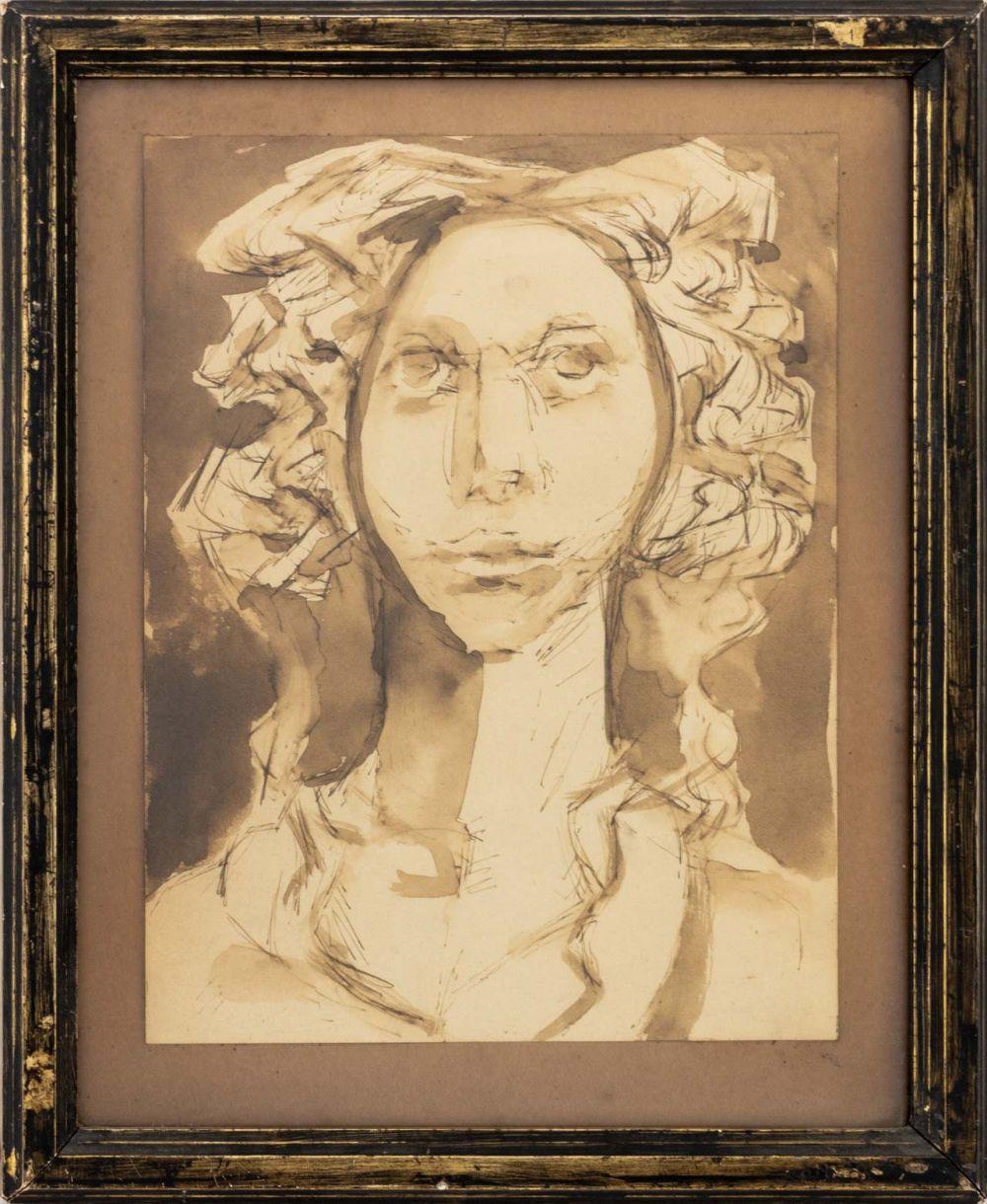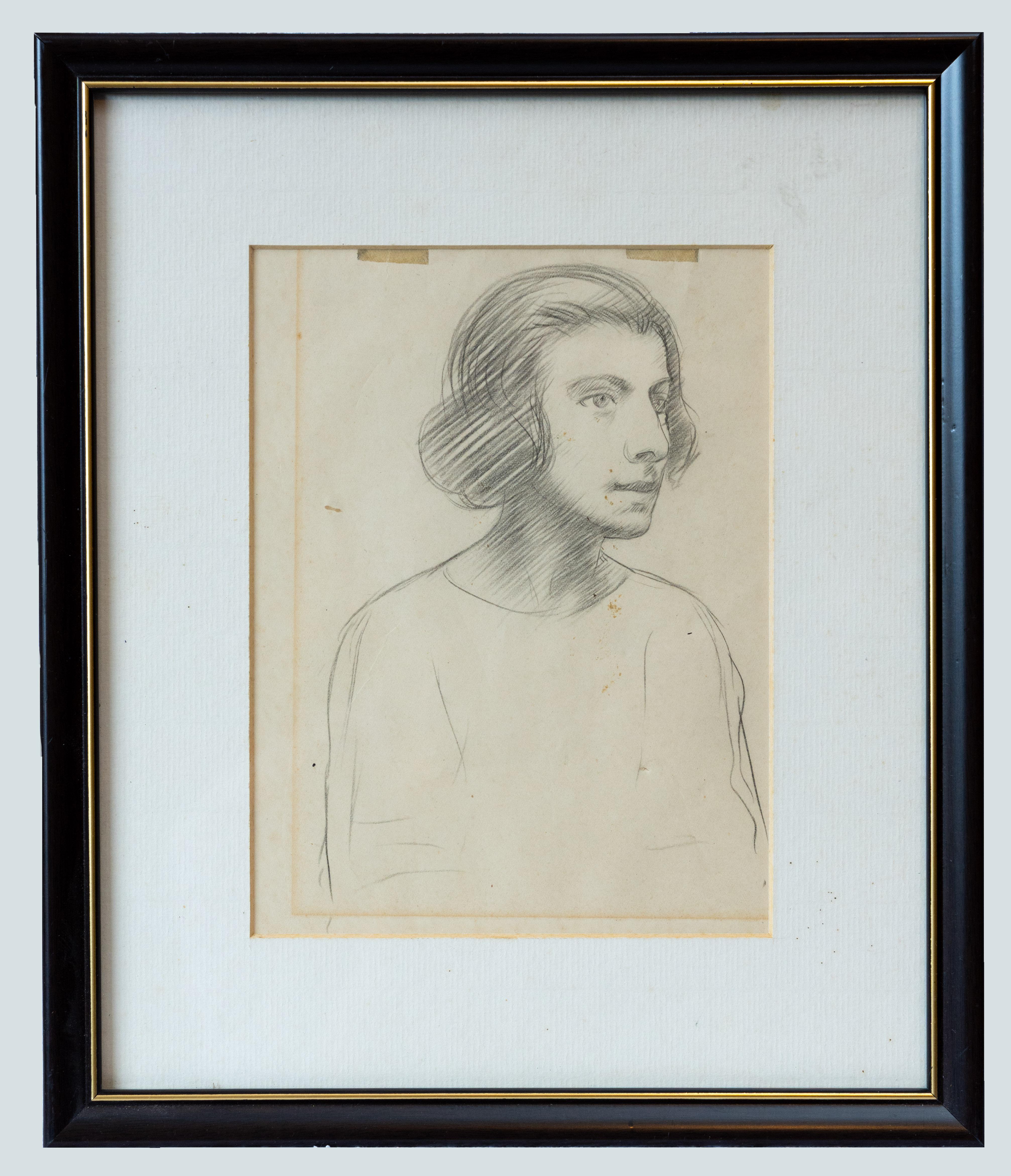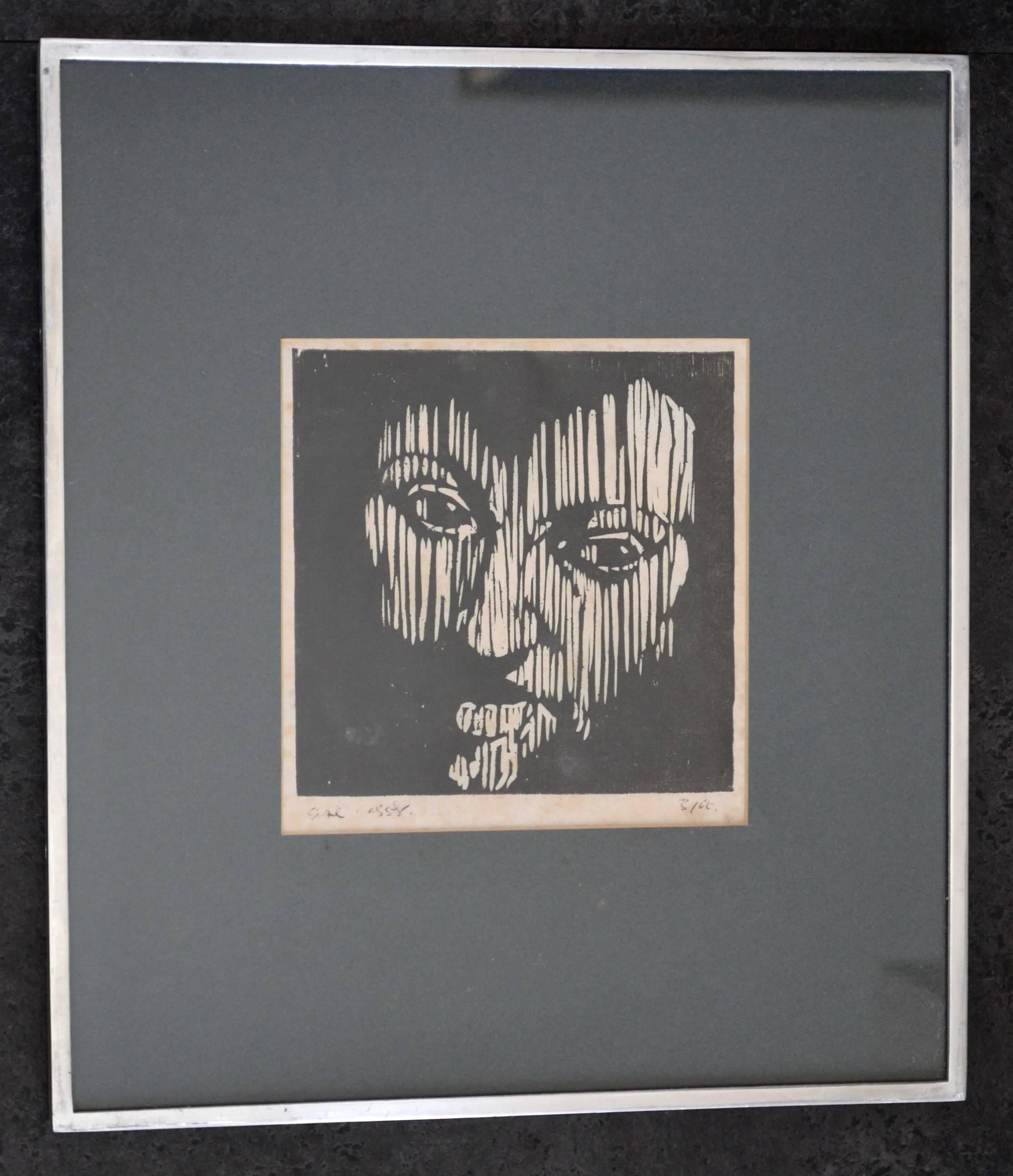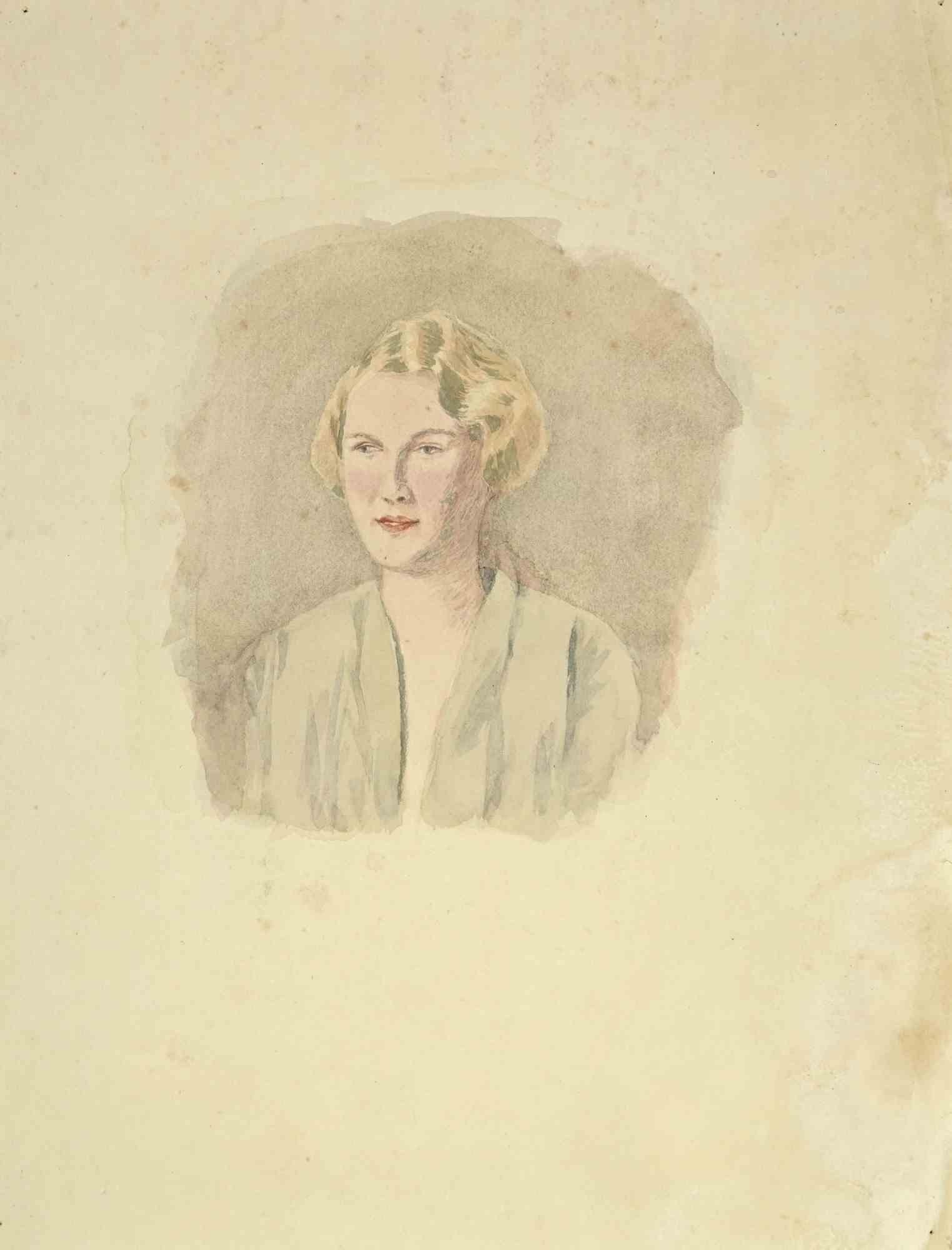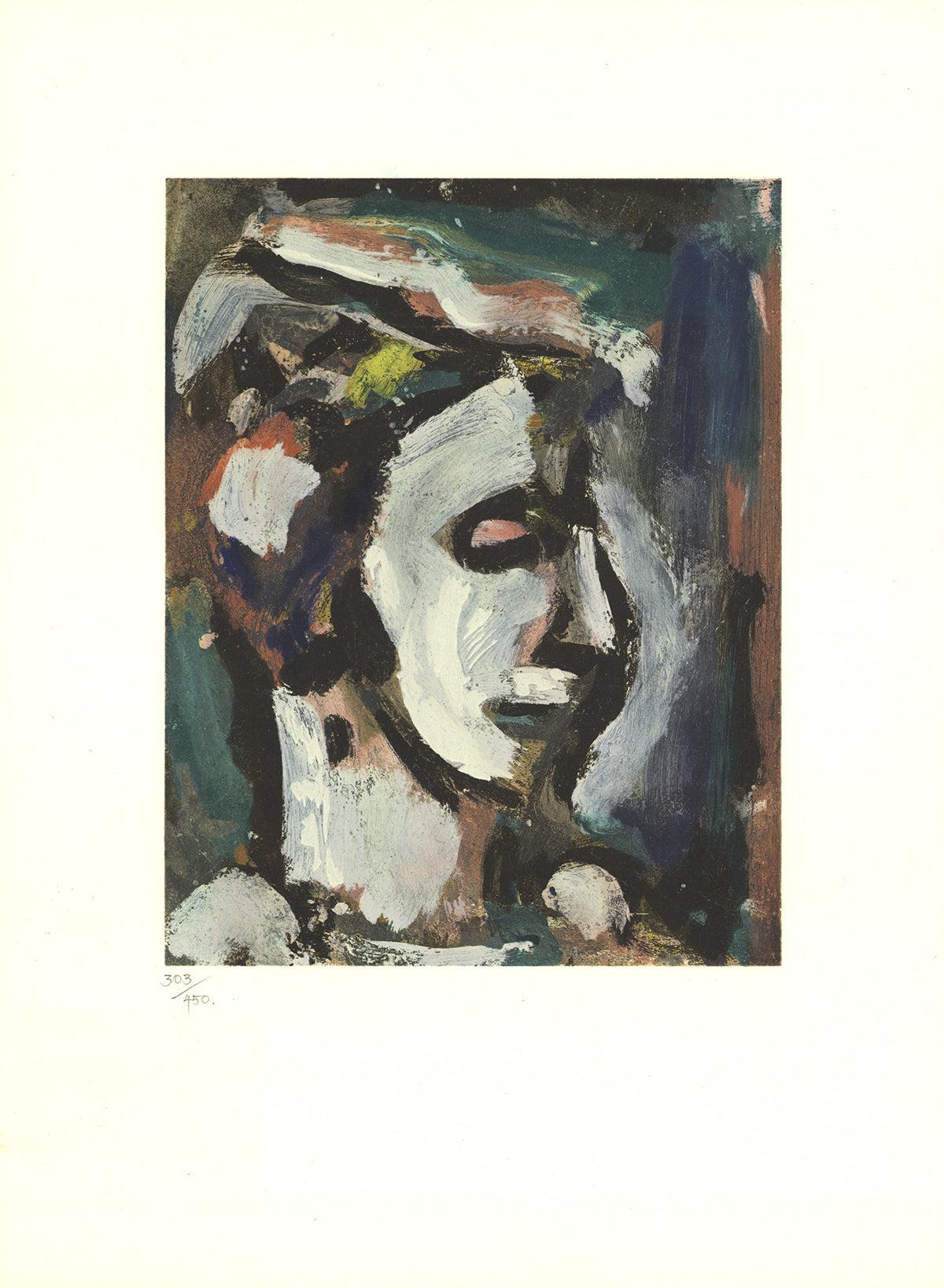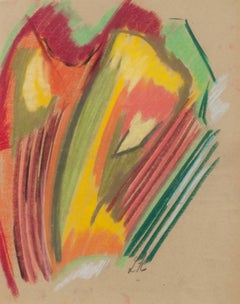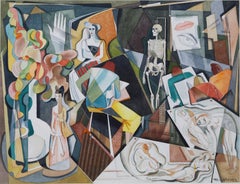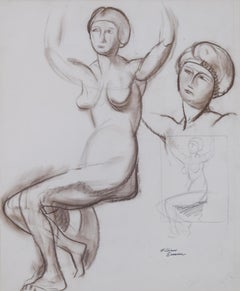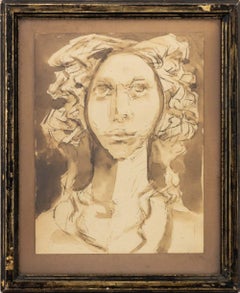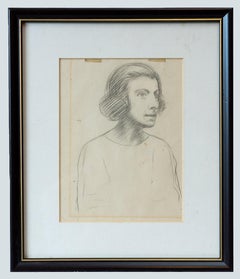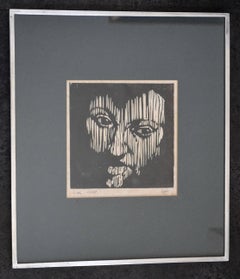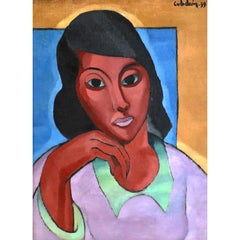Items Similar to Portrait of Gladys Anne Hoskyns
Want more images or videos?
Request additional images or videos from the seller
1 of 10
Portrait of Gladys Anne Hoskyns1923
1923
$1,250
£953.48
€1,086.31
CA$1,756.89
A$1,916.72
CHF 1,014.89
MX$22,967.72
NOK 12,925.19
SEK 11,819.12
DKK 8,111.30
About the Item
Portrait of Gladys Anne Hoskyns
Collotype after a Wyndham Lewis drawing, 1923
Singed in the plate and reinforced in pencil
Published by The Dial Publishing Company in Living Art: Twenty Facsimile Reproductions after Paintings, Drawings and Engravings and Ten Photographs after Sculpture by Contemporary Artists
Author/Publisher: Scofield Thayer
Edition: 500
These facsimiles, important modern art from Thayer's own collection. Includes some of the most important figures in both American and European art from this period such as Pablo Picasso, Henri Matisse, John Marin, Charles Demuth, Edvard Munch, Constantin Brancusi, Alexander Archipenko, et al.
The publication was influential in exposing the American intelligentsia to Modern European Art.
The original drawing that this callotype is after, is in the collection of the Metropolitan Museum of Art in New York, gift of Scofield Thayer.
Condition: Excellent
Archival framing by Shepherd Gallery Services, New York
Image: 14 x 11 1/2"
Frame: 25 1/4 x 23 1/2"
- Creation Year:1923
- Dimensions:Height: 14 in (35.56 cm)Width: 11.5 in (29.21 cm)
- Medium:
- Movement & Style:
- After:Percy Wyndham Lewis (1882 - 1957)
- Period:
- Condition:
- Gallery Location:Fairlawn, OH
- Reference Number:Seller: FA93661stDibs: LU14014779802
About the Seller
5.0
Recognized Seller
These prestigious sellers are industry leaders and represent the highest echelon for item quality and design.
Gold Seller
Premium sellers maintaining a 4.3+ rating and 24-hour response times
Established in 1978
1stDibs seller since 2013
834 sales on 1stDibs
Typical response time: <1 hour
Associations
International Fine Print Dealers Association
- ShippingRetrieving quote...Shipping from: Fairlawn, OH
- Return Policy
More From This Seller
View AllUntitled
By Leon Kelly
Located in Fairlawn, OH
Untitled
Pastel on paper, 1922
Signed with the artist's initials in pencil
Provenance: Estate of the artist
Francis M. Nauman (label)
Private collection, NY
A very early abstract/cubist work by Kelly. Created while the artist was studying with Arthur Carles in Philadelphia.
Leon Kelly (October 21, 1901 – June 28, 1982) was an American artist born in Philadelphia, PA. He is most well known for his contributions to American Surrealism, but his work also encompassed styles such as Cubism, Social Realism, and Abstraction. Reclusive by nature, a character trait that became more exaggerated in the 1940s and later, Kelly's work reflects his determination not to be limited by the trends of his time. His large output of paintings is complemented by a prolific number of drawings that span his career of 50 years. Some of the collections where his work is represented are: The Metropolitan Museum in New York, The Whitney Museum of American Art, the Museum of Modern Art, the Philadelphia Museum of Art, and Boston Public Library.
Biography
Kelly was born in 1901 at home at 1533 Newkirk Street, Philadelphia, PA. He was the only child of Elizabeth (née Stevenson) and Pantaleon L. Kelly. The family resided in Philadelphia where Pantaleon and two of his cousins owned Kelly Brothers, a successful tailoring business. The prosperity of the firm enabled his father to purchase a 144-acre farm in Bucks County PA in 1902, which he named "Rural Retreat" It was here that Pantaleon took Leon to spend every weekend away from the pressures of business and from the disappointments in his failing marriage. Idyllic and peaceful memories of the farm stayed with Leon and embued his work with a love of nature that emerged later in the Lunar Series, in Return and Departure, and in the insect imagery of his Surrealist work. "If anything," he once said,"I am a Pantheist and see a spirit in everything, the grass, the rocks, everything."
At thirteen, Leon left school and began private painting lessons with Albert Jean Adolphe, a teacher at the School of Industrial Art (now the University of the Arts) in Philadelphia. He learned technique by copying the works of the old masters and visiting the Philadelphia Zoo, where he would draw animals. Drawings done in 1916 and 1917 of elephants, snakes and antelope, as well as copies of old master paintings by Holbein and Michelangelo, heralded an impressive emerging talent. In 1917, he studied sculpture with Alexander Portnoff but his studies came to an abrupt halt with the start of World War I. Being too young to enlist, he joined the Quartermaster Corp at the Army Depot in Philadelphia, where he served for more than a year loading ships with supplies and, along with other artists, working on drawings for camouflage.
By 1920, the family's fortunes drastically changed. His father's business had failed due to the introduction of ready made clothing and his marriage, unhappy from the beginning, dissolved. Broken by circumstance Pantaleon left Philadelphia to begin a wandering existence looking for work leaving Leon to support his mother and grandmother. He found a job in 1920 at the Freihofer Baking Company where he worked nights for the next four years. Under these circumstances Leon continued to develop his skills in drawing and painting and learned of the revolutionary developments in art that were taking place in Paris.
During the day he was granted permission to study anatomy at the Philadelphia School of Osteopathy where he dissected a cadaver and perfected his knowledge of the human figure. He also met and studied etching with Earl Horter, a well known illustrator, who had amassed a significant collection of modern art which included work by Brancusi, Matisse, and Cubist works by Picasso and Braque. Among the artists around Horter was Arthur Carles, a charismatic and controversial painter who taught at the Pennsylvania Academy of Fine Arts. Leon enrolled in the Academy in 1922, becoming what Carles described as, "his best student".
In the next three years Leon work ranged from academic studies of plaster casts, to pointillism, to landscapes of Fairmount Park in Philadelphia, as well as a series of pastels showing influences from Matisse to Picasso. Clearly influenced by Earl Horter's collection and Arthur Carles he mastered analytical cubism in works such as The Three Pears, 1923 and 1925 experimented with Purism in Moon Behind the Italian House. In 1925 Kelly was awarded a Cresson Scholarship and on June 14 he left for Europe.
Paris
The first trip to Europe lasted for approximately three and a half months and introduced Kelly to a culture and place where he felt he belonged. Though he returned to the Academy in the Fall, he left for Europe again a few months later to begin a four-year stay in Paris. He moved into an apartment at 19 rue Daguerre in Paris and began an existence intellectually rich but in creature comforts, very poor. "I kept a cinderblock over the drain in the kitchen sink to keep the rats out of the apartment" he once explained. He frequented the cafes making acquaintances with Henry Miller, James Joyce and the critic Félix Fénéon as well as others. His days were split between copying old master paintings in the Louvre and pursuing modernist ideas that were swirling through the work of all the artists around him. The Lake, 1926 and Interior of the Studio, 1927, now in the Newark Museum.
Patrons during this time were the police official Leon Zamaran, a collector of Courbets, Lautrecs and others, who began collecting Kelly's work. Another was Alfred Barnes of the Barnes Collection in Philadelphia.
In 1929 Kelly married a young French woman, Henriette D'Erfurth. She appears frequently in paintings and drawings done between 1928 and the early 1930s.
Philadelphia
The stock market crash of 1929 made it impossible to continue living in Paris and Kelly and Henriette returned to Philadelphia in 1930. He rented a studio on Thompson Street and began working and participating in shows in the city's galleries. Work from 1930 to 1940 showed continuing influences and experimentation with the themes and techniques acquired in Paris as well as a brief foray into Social Realism. The Little Gallery of Contemporary Art purchased the Absinthe Drinker...
Category
1920s Abstract Abstract Drawings and Watercolors
Materials
Pastel
$4,000
The Model
By William C. Grauer
Located in Fairlawn, OH
The Model
Watercolor on paper, c. 1930
signed lower right (see photo)
Condition: Excellent
A few bits of adhesive residue verso
Colors fresh and unfaded
Housed in a Marin style meta...
Category
1930s American Modern Interior Drawings and Watercolors
Materials
Watercolor
Female Nude Study
By William Sommer
Located in Fairlawn, OH
Female Nude Study
Graphite and crayon on wove paper, c. 1928
Signed with the Estate stamp "B" (see photo)
Provenance: Estate of the Artist
Edward Sommer (his so...
Category
1920s American Modern Nude Drawings and Watercolors
Materials
Crayon
Preliminary Study for a Sculpture Project
By Boris Lovet-Lorski
Located in Fairlawn, OH
Preliminary Study for a Sculpture Project
Graphite, charcoal and wash on tracing paper, c. 1930-1940
Signed upper left and lower left (see both photos)
Created while the artist was l...
Category
1930s American Modern Figurative Drawings and Watercolors
Materials
Charcoal
Untitled (Portrait)
By William H. Bailey
Located in Fairlawn, OH
Untitled (Portrait)
Drypoint printed in blue-black graphite mixed with silver, 1974
Signed and dated lower ight (see photo)
From: Series entitled Six Drypoints
Edition: 23 (4/23)
Numbered lower left (see photo)
Print Shop: Crown Point Press
Printer: Jeannie Fine
Publisher: Parasol Press, New York
Note: A portfolio is in the collection of the National Gallery, Australia, Fine Arts Museums of San Francisco- de Young/Legion of Honor, Davis Museum at Wellesley College and the Yale University Art Gallery.
Condition: Excellent
Image/Plate size: 6 3/8 x 5 3/8 inches
Sheet size: 24 x 20 inches
From a portfolio of six drypoints, printed with unqiue combination of blue-black graphite shavings combined with silver to create the appearence of an original drawing. I know of no other artist to use a similar printing technique.
William Bailey studied art at the University of Kansas, Yale University and Yale School of Art where he studied with Josef Albers receiving his MFA in 1957.
Mr. Bailey’s first exhibition in New York was at Robert Schoelkopf Gallery in 1968, where he showed regularly until its closing in 1990. During the 90’s he exhibited at the Andre Emmerich Gallery and on its closing, exhibited at the Robert Miller Gallery. In 2004 Bailey moved to the Betty Cuningham Gallery where his most recent exhibition was held from April 30 - June 11, 2016.
Mr. Bailey’s work has been exhibited extensively in both America and Europe. He is represented in the collections of The Whitney Museum of American Art, The Museum of Modern Art, the Pennsylvania Academy of Fine Arts, and the Hirschhorn Museum and Sculpture Garden, among others. He was awarded a Guggenheim Fellowship in painting in 1965. Mr. Bailey was elected to The National Academy of Design in 1983 and to The American Academy of Arts and Letters in 1986.
Mr. Bailey taught at The Yale School of Art from 1958 to 1962 and from 1969 to 1995. He has also taught at The Cooper Union, University of Pennsylvania and Indiana University. He maintains studios in New Haven and in Umbertide, Italy.
Courtesy Betty Cunningham Gallery
Tribute to William Bailey
THE NEW YORK TIMES
William Bailey, whose pristine, idealized still lifes and female nudes made him one of the leading figures in the return of figurative art in the 1980s, died on April 13 at his home in Branford, Conn. He was 89.
His death was confirmed by his daughter, Alix Bailey.
Beyond his painting, Mr. Bailey influenced generations of students in his many years as a teacher at the Yale School of Art.
In some of his best-known work, Mr. Bailey arranged simple objects — the eggs, bowls, bottles and vases that he once called “my repertory company” — along a severe horizontal shelf, or on a plain table, swathing them in a breathless, deceptively serene atmosphere heavy with mystery.
William Bailey, Modernist Figurative Painter, Dies at 89
He swathed his nudes and still lifes of eggs, vases, bottles and bowls in a breathless, deceptively serene atmosphere heavy with mystery.
The painter William Bailey in 2009. He was never given a career survey in a major museum, but his influence, particulary on students at Yale, was deep.
Ford Bailey
By William Grimes for the New York Times
April 18, 2020
William Bailey, whose pristine, idealized still lifes and female nudes made him one of the leading figures in the return of figurative art in the 1980s, died on April 13 at his home in Branford, Conn. He was 89.
His death was confirmed by his daughter, Alix Bailey.
Beyond his painting, Mr. Bailey influenced generations of students in his many years as a teacher at the Yale School of Art.
In some of his best-known work, Mr. Bailey arranged simple objects — the eggs, bowls, bottles and vases that he once called “my repertory company” — along a severe horizontal shelf, or on a plain table, swathing them in a breathless, deceptively serene atmosphere heavy with mystery.
His muted ochres, grays and powdery blues conjured up a still, timeless world inhabited by Platonic forms, recognizable but uncanny, in part because he painted from imagination rather than life.
“They are at once vividly real and objects in dream, and it is the poetry of this double life that elevates all this humble crockery to the realm of pictorial romance,” Hilton Kramer wrote in The New York Times in 1979.
Mr. Bailey’s female figures, some clothed in a simple shift or robe and others partly or entirely nude, are disconcertingly impassive, implacable and unreadable, fleshly presences breathing an otherworldly air.
The critic Mark Stevens, writing in Newsweek in 1982, credited Mr. Bailey with helping to “restore representational art to a position of consequence in modern painting.”
But his version of representation was entirely idiosyncratic, seemingly traditional but in fact “a modernism so contrarian,” the artist Alexi Worth wrote in a catalog essay for the
William Harrison Bailey...
Category
1970s Realist Portrait Prints
Materials
Drypoint
Untitled
By Leon Kelly
Located in Fairlawn, OH
Untitled
Pastel on paper, 1922
Initialed lower right (see photo)
Exhibited: Francis Nauman, Leon Kelly: Draftsman Extraordinaire, New York, April 4 - May 23, 2014.
Condition: Excell...
Category
20th Century American Modern Abstract Drawings and Watercolors
Materials
Pastel
$4,000
You May Also Like
Portrait of a Woman
By Leonor Fini
Located in Astoria, NY
Leonor Fini (Argentine/Italian, 1907-1996) Attributed, Portrait of a Woman, Watercolor on Paper, apparently unsigned, partial paper label reading "Robert Sa ..." verso, giltwood fram...
Category
Mid-20th Century Modern Figurative Drawings and Watercolors
Materials
Paper, Watercolor
Portrait of a woman, signed "Frank Jameson" in the back (1898-1968)
By Frank Jameson
Located in GB
This finely rendered pencil drawing by British artist Frank Jameson depicts a contemplative female sitter in three-quarter view. Executed with delicate, confident linework and subtle...
Category
20th Century Portrait Paintings
Materials
Paper, Pencil
Portrait
By Gerald Anthony Coles
Located in Brecon, Powys
Gerald Coles - Original 1958 Woodcut. Signed and dated in pencil lower left corner. On Japan paper. Numbered 3/60. In fine condition.
Gerald Anthony Co...
Category
1950s Modern Figurative Prints
Materials
Woodcut
A colorful modernist portrait painting of a young woman, Latin American
Located in Colfax, CA
A bold and colorful modern portrait painting of a young woman, clearly signed, and dated 1939.
We have been unable to find a listed artist that matches the name, Carlos Leon. and tim...
Category
1930s Modern Portrait Paintings
Materials
Oil
The Portrait - Drawing - Mid 20th century
Located in Roma, IT
The Portrait is a drawing realized by an anonymous in the mid-20th century.
Pencil and watercolor drawing on paper.
Good conditions with foxing.
Category
Mid-20th Century Modern Figurative Drawings and Watercolors
Materials
Pencil, Watercolor
Camille Portrait
By (after) Georges Rouault
Located in Brooklyn, NY
This lithograph, titled Portrait of Camille, is a significant work by the French Fauvist artist Georges Rouault. Executed with precision by lithographer Daniel Jacomet, this print is...
Category
Late 20th Century Modern Portrait Prints
Materials
Lithograph
$320 Sale Price
20% Off
More Ways To Browse
Antique Reproduction Paintings
Oreo Art
Orientalist Prints Art
Paul Mccrane
Peter Max Moon
Picasso Banderilles
Picasso Clown
Picasso Etching Vollard Suite
Picasso Les Dejeuners
Picasso Lithograph 1974
Picasso Silkscreen
Polo Antiques
Pop And Scott
Punk Original
R C Gorman Originals
Rene Magritte Poster
Retro Library Posters
Reynolds Etching
